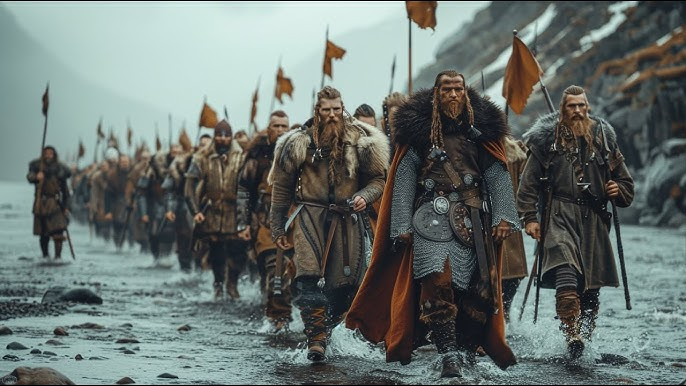The term "Viking" originates from the Old Norse word víking , which could mean plunder, expedition, exploration, or piracy. It was used primarily by those who suffered from Viking attacks, describing groups of Scandinavian sailors who sailed the seas and rivers between 750 and 1050 AD, the period we now know as the Viking Age.
This word reflects both the threat they represented and the capacity for exploration and trade that characterized these peoples.

Viking expansion and society
The Viking Age, which lasted from the late 8th to the early 11th century, was a period of significant expansion of the Scandinavian peoples beyond their homeland.
Factors such as population pressure, political instability and the search for wealth motivated their expeditions.
Viking armies were made up primarily of free farmers who, during the summer, set out on sea voyages to plunder and trade goods such as furs, tusks, and seal blubber.
Initially, the attacks were swift and surprising, but by the mid-9th century the Vikings had begun to spend the winters in the conquered territories, consolidating their control and establishing long-term dominions.
Viking society was organized into independent clans and chieftains, which facilitated flexibility in raiding, trading, and colonization.
Thanks to their longboats, capable of navigating shallow seas and rivers, the Vikings traveled great distances and established trade routes connecting East and West, reaching the Byzantine Empire and the Islamic Caliphate, leaving their mark on northern Europe, the British Isles, the continental interior, and the Mediterranean.
Genetic influence and Viking expansion routes
The Vikings also left a significant genetic imprint on the local populations.
The Norwegians moved toward Ireland, Scotland, Iceland, and Greenland; the Danes toward England; and the Swedes eastward, traveling through the Baltic, Poland, and the rivers of Russia and Ukraine. High genetic diversity is observed in some coastal areas and trading centers, while the Scandinavian interior remained more stable, demonstrating that Viking identity was more social and cultural than strictly genetic.
Currently, it is estimated that around 6% of the UK population and up to 10% of those in Sweden retain Viking DNA, confirming that their legacy was biological, cultural, and political.

Colonization and cities founded by Vikings
The Vikings founded numerous cities and colonies, such as Dublin in Ireland and Normandy in France.
Between 879 and 920, they colonized Iceland, which served as a base for exploring Greenland. Archaeological evidence from L'Anse aux Meadows, Newfoundland, shows they arrived in North America around 1000, long before Christopher Columbus.
Although their population was small and dispersed, the Vikings conquered and colonized large territories.
The Norwegians were noted for their courage on long sea voyages; the Danes focused on England and France, leaving a lasting mark on their language and culture; and the Swedes were active in Eastern Europe, contributing to the formation of Kievan Rus'.
Viking-style burials have been found in Britain with individuals of local ancestry, demonstrating a high degree of cultural and genetic integration.
What was Viking trade and daily life like?
Far from being just warriors and raiders, many Vikings lived as traders and farmers, bartering and farming their lands.
Daily life also included celebrations and drinks such as mead, a fermented honey beverage similar to beer, which was part of their social culture.

When was the end of the Viking Age?
The Viking Age began with the attack on Lindisfarne Monastery in 793 and ended in 1066 with the death of King Harald Hardrada at the Battle of Stamford Bridge.
Internal disputes and organized resistance by European countries led to their decline, but they left a cultural, genetic, and commercial legacy that can still be traced in European history.
Don't forget to check out our Medieval Shop and the Viking Age collection we have to offer.









